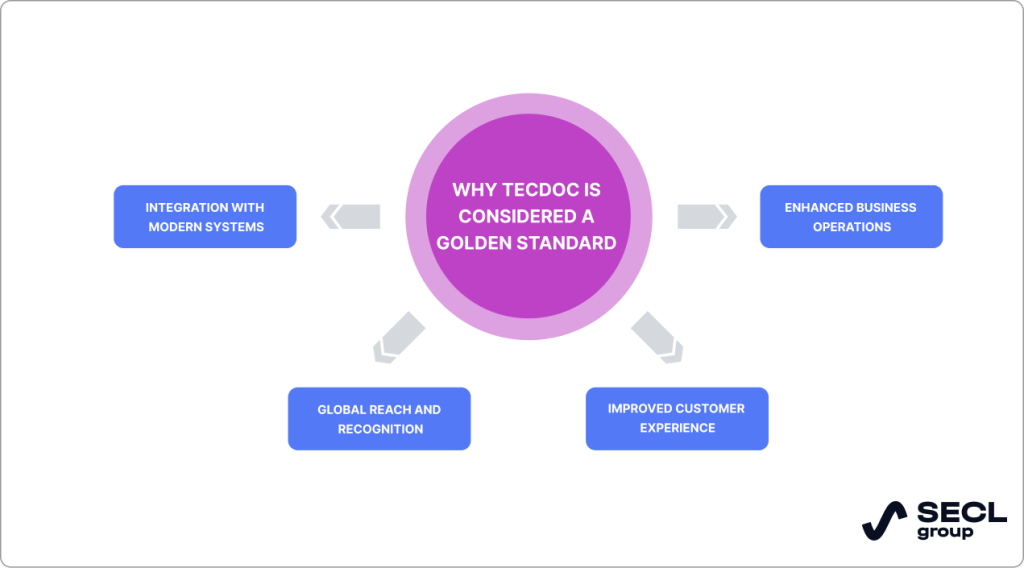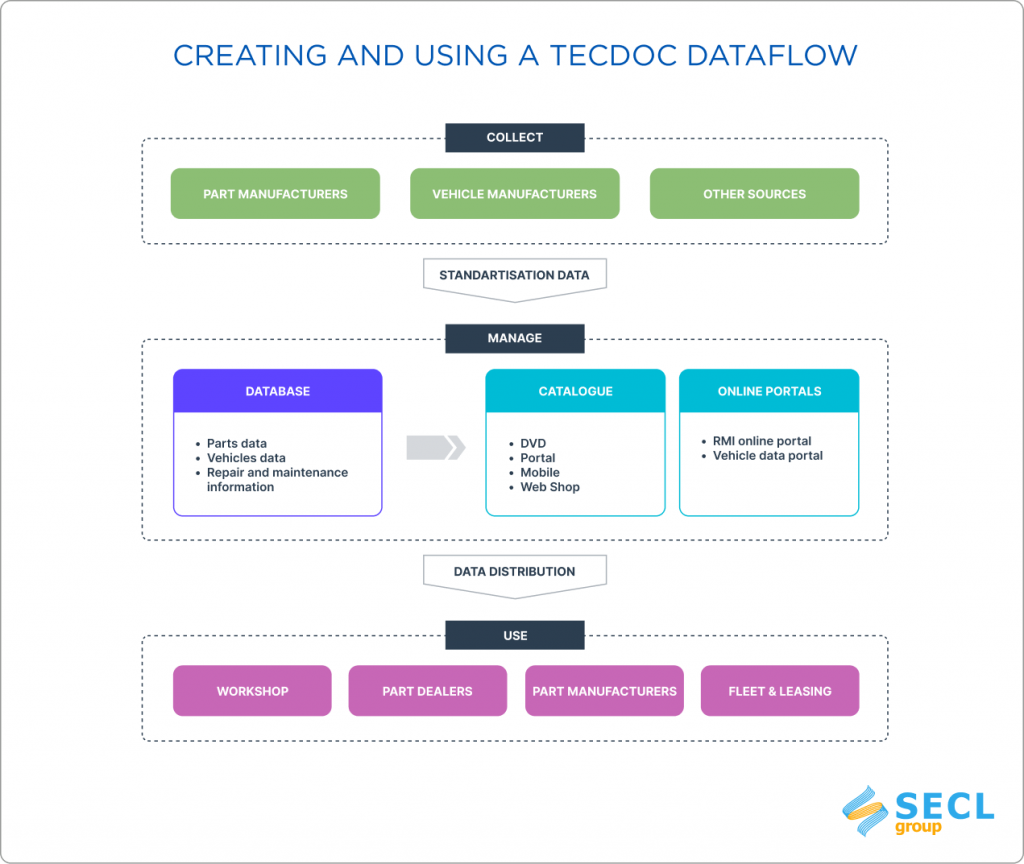Auto Parts Database Integration: What’s What
TecDoc integration: Basic things to know
- What is TecDoc?
- Auto parts database integration in the online store
- Shopping personalization with TecDoc website integration
- Self-Promoted Auto Parts Catalog
- TecDoc integration for auto parts marketplace
TecDoc integration project specifics
- Technology selection for projects involving TecDoc website integration
- Our experience with e-commerce projects
- TecDoc integration project budget
Software development projects demand both technological expertise and domain-specific knowledge from developers. For instance, we have a strong history in web development for the automotive sector, making it one of our primary industry specializations, and we’ve successfully executed projects for renowned automotive corporations like Kia, Mazda, Hyundai, and more. While I’ve discussed some of these projects in previous blog entries, this publication will focus on our experience with TecDoc database integration.
The automotive industry isn’t just about manufacturing and selling new cars. It encompasses the repair and maintenance of used vehicles. The auto parts market is vast and changing. By providing exceptional service, there’s always an opportunity for a company to establish its presence in this space, which is where exploring auto parts catalogs integration may come in particularly beneficial.
In this article, I will delve into how to efficiently undertake such an integration, and what you need to consider so that quick and convenient access to the auto parts catalog becomes a competitive advantage for your business.
Auto Parts Database Integration: What’s What
The car repair and maintenance industry is enormous, with global demand for auto parts underscoring the critical need for accurate and timely data. However, managing such extensive and intricate data is no small task.
Consider this: globally, there are hundreds of recognized auto and motorcycle brands. Each brand boasts a variety of models, and these models often come with versions differing by their production year. Moreover, the auto parts sector is in a state of constant evolution; a part considered vital today could be rendered obsolete in just a decade.
In light of these challenges, it’s no wonder auto parts databases must monitor tens of millions of items, all needing frequent updates. This places online auto parts retailers in a tight spot. They struggle with vast data amounts. At the same time, they strive to provide their customers with accurate information.
It is even more complex with various stakeholders, such as manufacturers, wholesalers, and intermediaries. Other hurdles to navigate include keeping real-time stock updates, procuring specific parts for individual clients, selecting items based on VIN, identifying suitable alternatives, and more.
Yet, challenges often pave the way for innovation. In response to this demand, several companies have risen to the task, crafting and regularly updating auto parts databases. These databases are invaluable assets, trusted by everyone from small auto service outfits to major car manufacturers.When implemented correctly, auto parts database integrations can significantly enhance the efficiency and service quality of online auto stores and marketplaces.
TecDoc integration: Basic things to know
Wondering where you can access a comprehensive and up-to-date database of auto parts? This leads us to the TecDoc auto parts database. But what exactly is TecDoc, and how does it distinguish itself from other similar databases?
Just like any committed software development company, we put our customers’ needs first. Through our work, we’ve noticed that our clients in the auto parts sector often ask for TecDoc integration, underscoring its importance in the automotive industry.
What is TecDoc?
TecDoc Catalogue by TecAlliance is the leading global auto parts database, continually updated as automakers provide the latest details about their products. Housing tens of millions of items, the database offers comprehensive information on each spare part and highlights potential correlations. Almost every auto service station relies on the TecDoc Catalogue to select spare parts for customer vehicles.
The TecDoc information base is unmatched in its scope and detail. It covers over 1,000 brands, 190,000 vehicle types, 9.8 million articles, and 9,800 standardized product descriptions. To enhance user experience and ensure relevancy, the catalogue tracks over 450 million vehicle linkages. Notably, TecDoc’s ability to precisely pinpoint the required auto parts has cemented its status as the benchmark in the automotive aftermarket industry.

At SECL Group, our first experience of a TecDoc integration project came back in 2010. At the time, there wasn’t an official API for the catalogue, so our task involved transforming the offline program’s database into an online format before linking it to an online store. We introduced an advanced search function for spare parts based on various criteria, including name, brand, original catalog number, customer’s internal catalog number, and parts category tree, also making use of the “Your Car” tool. This marked our inaugural experience with TecDoc webshop integration.
At present, numerous auto parts databases can be found online. However, they all typically either function on the TecDoc framework or focus on specialized segments not yet encompassed by TecDoc. TecDoc’s direct relationships with car manufacturers, which provide real-time, accurate information, set it apart in the marketplace. For businesses in car repairs or auto parts sales, TecDoc website integration can boost sales and improve customer experience.

Auto parts database integration in the online store
Previously, I mentioned our early experience with converting offline databases for online stores and marketplaces that deal in auto parts. But today, there’s an official API that has streamlined the process of TecDoc webshop integration. This allows you to integrate either the full database with millions of items or just a segment of it.
Commonly, users choose to integrate a smaller portion – perhaps data related to 2-3 manufacturers they collaborate with. This results in a manageable database of several thousand or even tens of thousands of spare parts.
However, for entities operating at a larger scale, like online marketplaces, a complete database integration becomes essential. But as you can imagine, the more extensive the product catalog, the harder the process to implement an auto parts database integration project becomes.
Few stores globally hold catalogs with tens of millions of items; this is typically the preserve of giant, Amazon-sized entities. Smaller stores usually handle much more limited product ranges. Attempting to upload an exhaustive parts catalog onto platforms like Magento may be counterproductive, as it could significantly slow down the system. Thus, the pragmatic approach is to only integrate data essential for daily operations.
Again, it’s worth underscoring the depth of the undertaking when it comes to TecDoc webshop integration, as it isn’t simply a matter of linking the catalog to your business website. The database houses a huge amount of additional information and internal relationships which your customers might need access to.
As an example, many businesses will need to sync TecDoc with their accounting system to establish a complete picture on the auto parts range you’re offering. While TecDoc provides intricate product details, your accounting system (like Xero, for instance) offers insights into prices and availability. By linking the two systems using product IDs, the product page on your website can display comprehensive data, ensuring customers receive all of the most relevant information, from technical specifications to pricing and purchase availability.
The core challenge of TecDoc integration lies in establishing connections like this, and teams unfamiliar with the process can easily find themselves overwhelmed when navigating these relationships.
Looking for an experienced API integration team?
Reach out to us for a consultation on integrating third-party services into your solution.
Shopping personalization with TecDoc website integration
In our first TecDoc integration project, we introduced a feature allowing users to select auto parts using their vehicle’s VIN. Upon entering their vehicle and other details, users were directed to a section of the catalog showcasing parts compatible with their car. Furthermore, recognizing that not every user might want or be able to purchase an original spare part, we accommodated alternatives.
While there are spare parts from original equipment manufacturers (OEMs), the aftermarket-based also presents offerings from companies that manufacture alternatives or even enhanced versions of these OEM parts.
Processing and cross-referencing between OEM parts and alternatives from other suppliers involve handling a considerable amount of data. Hence, our system not only displayed original parts but also provided suitable analogs for the user’s vehicle.
Online retail is increasingly leaning towards personalized sales offers. With TecDoc integration, this personalization is elevated, given its access to a vast data reservoir. Such integration is invaluable and can be implemented in varied ways. In certain TecDoc integration projects, especially for smaller car services working with a limited range of automotive brands, we prioritized displaying only parts from pertinent manufacturers.
Integrating personalization into your online store can really pay dividends. By harnessing the TecDoc Catalogue data and maintaining a record of customer transactions, along with effective communication and knowledge of their vehicles, you can craft more targeted sales offers.
Self-Promoted Auto Parts Catalog

I’ve been involved in web projects for nearly two decades, boasting both technical and marketing expertise. I remember vividly when we were initiating our maiden TecDoc website integration, our client asked me, “How do we plan to market this?”
Back then, search engines were the clear and obvious choice for promoting a TecDoc-integrated website. And whilst search engine optimization remains a primary promotion tool for online stores today, it’s important to note that cost per lead and promotion timings have increased.
Furthermore, the question of how you promote web resources comprising tens of millions of pages also poses challenges. For me, the focus here shouldn’t be solely on post-launch advertising campaigns, but on developing your website correctly from the outset to ensure easy promotion later on.
With this in mind, we have introduced and implemented innovative website development strategies that enable online stores with expansive catalogs to solidify their market stance.
Our approach includes:
- Structured Architecture: We devise a tree-like architecture of catalogs based on multiple criteria, such as spare part type and car brand. This allowed users to navigate both generic pages like “Batteries” and specific ones like “Batteries for Kia”.
- Geolocation Integration: By considering the seller’s geolocation, users can locate the parts they need within their cities. This leads to the creation of pages like “Batteries for Kia in London”.
- Comprehensive Cataloging: We catalog all auto parts in the online store and automate the generation of page metadata. This results in detailed pages such as “Hyundai Batteries for Kia in London”. The system is designed to auto-create similar pages for every item in the store.
Thanks to such innovations, one of our clients saw over 10,000 visitors from a single country in their online store’s debut month – all without additional promotional or advertising expenditure. Unsurprisingly, sales surged.
TecDoc integration for auto parts marketplace
In the world of automotive e-commerce, online auto parts marketplaces have a significant niche. Our portfolio includes various marketplaces and online stores. Many of them focus on auto parts. The auto parts sector is particularly suitable for marketplace models due to the multitude of parts manufacturers, intermediary vendors, analog part options, and a thriving market for used parts.
Incorporating integrations like TecDoc into these marketplaces can significantly enhance user experience, as such integrations allow platform users to sift through multiple vendors offering the same product, ensuring they get the best deal.
Drawing from my experience, I’d advise you to showcase analog or alternative parts alongside every listed product. This is because users appreciate options – some might not wish to shell out for an original part, or would prefer not to endure lengthy delivery times. Further enriching your platform with value-added services, such as a repair cost estimator or car customization suggestions, can also substantially amplify user engagement.
Marketplace models are potentially extremely lucrative in any national market with sizable populations of upwards of tens of millions. And if you follow the principles I’ve outlined above when creating your in-house auto parts catalog, you can expect to propel your platform’s traction and visitor count, all without incurring extra promotional costs at the outset.
TecDoc integration project specifics
TecDoc e-commerce integration can be a game-changer, offering multiple avenues to boost both customer reach and sales. However, to harness these opportunities, it’s crucial to navigate the integration process correctly.
Technology selection for projects involving TecDoc website integration
There has been a surge in out-of-the-box solutions for TecDoc integration recently, and there’s always the temptation to use such products. In my view though, when it comes to TecDoc integration, this is the wrong move. Here’s why:
Essentially, many of the current off-the-shelf solutions offer the TecDoc base with a basic user interface (UI) on top. A significant portion lack fully fledged product catalogs, and even if some do provide them, their promotional potential remains limited. The main reason is that these templated pages often get indexed poorly by search engines like Google.
Honestly, I’ve yet to come across a thriving auto parts sales project that leans on such off-the-shelf solutions. Simply put, your product doesn’t cater anywhere near enough to the growth aspirations and market positioning objectives of any ambitious online store.
In my view, features like an intuitive search function, relevant alternatives, personalization, and comprehensive item information (both technical and commercial) are not just added bonuses; they’re essential.
Moreover, remember that auto parts database integration isn’t just useful for enhancing your e-commerce platform; it can also add value to any internal automated systems too, such as Enterprise Resource Planning (ERP), Product Information Management (PIM), and Order Management (OM) systems.
Working holistically like this can avoid unnecessary duplication of information, optimize planning and documentation processes, and refine resource allocation. Therefore, for those aiming to maximize the benefits of TecDoc e-commerce platform integration, a custom-built solution that takes all of your business processes into account is a route I’d strongly recommend.
When it comes to the tech stack of projects like this, bear in mind that TecDoc data integration can be created using almost any modern programming language and framework. All elements of the tech stack, including languages and frameworks, need to be selected based on the requirements gathered for the online store or marketplace. Third-party API integrations, including TecDoc, do not influence the choice of technologies.
Our experience with e-commerce projects
Our teams prefer to use Python, JS, or PHP in e-commerce projects. While TecDoc integration will be the highlight of your web resource, the site’s reliability, usability, and advanced capabilities hinge on tailored software requirements and development – an area where our expertise can be invaluable.

We mainly integrated TecDoc into online auto parts stores, from those common to all manufacturers to small ones with 2-3 car brands. We also often integrated TecDoc into internal B2B systems for wholesale sales. Such e-commerce platforms were simultaneously integrated with TecDoc (auto parts database), with an accounting program (prices and availability), and with delivery/payment systems to buy directly on the website. All this worked together, data was uploaded into each product card from several places.
In some cases, we enabled entering your VIN code. Then, the entire auto parts catalog was adjusted to a specific car. Almost all projects included analogs, so if there was no spare part in stock, you could buy an analog or order this spare part.
SEO requirements were also an important consideration. The TecDoc database consists of tens of millions of products and there are now a lot of online auto parts stores. Everything had to be done correctly so that the site would be indexed efficiently in Google and traffic would pass to it
We have vast experience working with e-commerce projects of different sizes and complexity levels. We can handle any request from basic online stores to large-scale marketplaces that handle millions of visitors per month. For instance, SECL Group team developed one of the largest B2B platforms in the world for Kia, a complex retail store for Danone, and promotional websites for PepsiCo.
TecDoc integration project budget
TecDoc integration, especially now that an API is available, isn’t overly time-consuming. However, it does demand specific expertise. To give you an idea, as of now, over 1,000 companies subscribe to the TecDoc web service API.
(By the way, there’s also the option to directly tap into the spare parts database by routinely obtaining the TecDoc Data Package. With this, developers can craft a bespoke internal auto parts catalog tailored for retail or auto repair businesses).
For a straightforward integration meeting basic needs, the project might span anywhere from a few dozen to several hundred hours, translating to a budget of about $3,000 to $5,000.
Should you opt for a more intricate integration with added data processing functionalities however, the budget can escalate into the tens of thousands. The lion’s share of these expenses is typically allocated to the creation of the e-commerce platform, be it a store or marketplace, and the accompanying e-commerce systems (which we wrote about in a separate article). As a point of reference, launching an online store from the ground up could start at $50,000, while an online marketplace could begin at $100,000 and increase from there.
From our past work, clients who’ve carried out TecDoc webshop integration with our guidance have found that such investments quickly prove their worth. The return is evident in the surge of customer traffic, enhanced customer loyalty, and a noticeable uptick in sales.
Conclusion
Modern auto parts databases, particularly industry leaders like TecDoc, are vast and intricate tools. However, incorporating them into your online auto store or specialized marketplace can offer significant advantages. TecDoc integration can undoubtedly enhance your platform’s value, but it demands a seasoned development team well-versed in the automotive sphere and familiar with the catalog’s intricacies and integration capabilities. When executed properly, this project can be a pivotal growth catalyst for your enterprise.
Our primary expertise lies in the automotive sector, including the aftermarket, so beyond the TecDoc website integration case study detailed in this article, we possess a wealth of knowledge to share with you.
TecDoc can propel your auto parts venture forward. Reach out for insights on your projects; we look forward to guiding you in identifying opportunities to elevate your business.